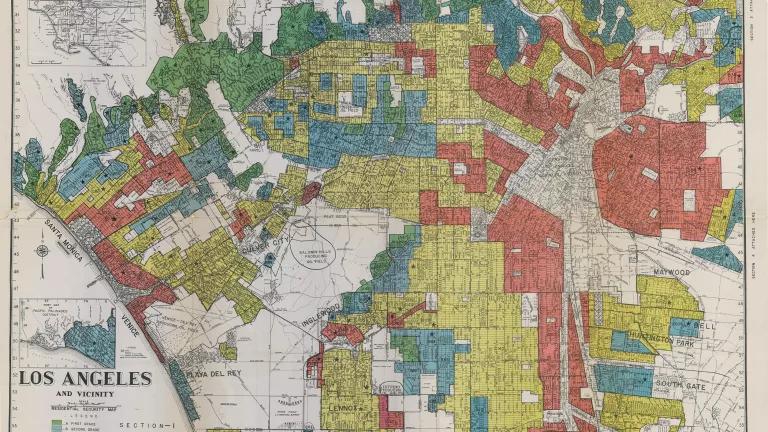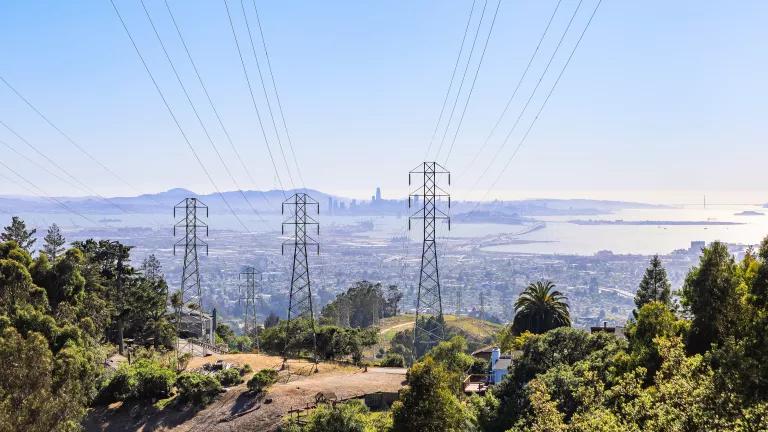BREAKING NEWS: 60 years of government structures and polices that subsidize sprawl development have not been dismantled in nine short months by San Diego’s new regional plan! Like so many attention grabbing stories, Ethan Elkind’s blog post proclaiming California’s first Sustainable Communities Strategy (SCS) a “dud” is a poorly informed piece that doesn’t do justice to the movement for sustainable, equitable communities.
Yes, San Diego County’s draft SCS, compiled by its regional agency SANDAG, needs significant improvement. But we never expected SB 375 to work overnight. With some additional changes that can be made to SANDAG’s SCS by October, as well as commitments we would like to see SANDAG make for policy change over the next few years, it is still possible for this first SCS under SB 375 to provide a critical pivot away from the continued paradigm of poorly planned, unaffordable, sprawl development.
On the transportation side, Elkind is right that one of SANDAG’s big constraints, not automatically undone by SB 375, is that they passed a 40 year sales tax known as TransNet that contains significant amounts of highway expansion, as well as bus rapid transit, light rail, commuter rail, smart growth, and habitat protection funding. Many of the highway expansions are planned for the next 20 years, and the fact that they were not jettisoned or moved to the end of the plan is certainly a tremendous shortcoming of this draft SCS. But that does not mean that paradigm change is out of the question; it is simply that it will take longer than the instant gratification many advocates and academics would like.
Even sticking with this one point on transportation investment, there has been some positive direction change in San Diego County because of SB 375.
- In mixing and matching three different transportation scenarios, SANDAG ultimately adopted a hybrid that includes several transit projects not contained in the initial scenarios. In total the plan includes $53 billion for transit operations and maintenance – more money and a higher percentage of funds than ever before. Unfortunately, too much of that transit is planned in the SCSes ‘out’ years (see recommendations below).
- There has been a growing chorus demanding a re-examination of all of these highway projects – including most recently a powerful resolution from the San Diego City Council (with the City holding 40% of the voting power on SANDAG) calling for a refocusing of investment to support transit and smart growth.
- Senator Kehoe pointed to SB 375 and the regional Greenhouse Gas (GHG) targets while fighting the super-sizing of I-5. As of last week, Caltrans and SANDAG agreed to get rid of the two new proposed mixed flow lanes, for a savings of $1 billion, and accelerate transit in the corridor. (The proposal for the remaining four priced or “managed” lanes will still move forward).
- With so much of the long-term funding allocated for TRANSNET projects, only about 3% of the $110 billion was considered discretionary. Still, $2.5 billion of that was dedicated to bicycle and pedestrian improvements, a 350% increase over the last plan.
On the land use side, SANDAG did little to challenge general plans that allowed sprawl development to continue, and Elkind correctly points out that SANDAG is made up of local elected officials, making this a tricky exercise. But even within that framework, the housing mix included in the SCS is reflective of coming shifts in the housing market. A full 80% of new growth between 2010 and 2050 will be in multi-family housing, the vast majority of which would be in transit priority areas.
And potentially as important to the policy details in the plan is that SB 375 is bringing diverse new voices into the debate over regional planning—a debate that (outside the Bay Area) has been a lonely one for long-time advocates. Sustainable San Diego, a new broad-based regional coalition of environmental, social equity, public health and other stakeholders formed on the heels of SB 375. As in other regions of the State, these coalitions are forming around the potential to impact SCSes, and are more likely to affect even more powerful changes over the coming years, when they have more time to truly prepare alternative analyses and build joint agendas and campaigns far ahead of time.
Where SANDAG’s plan truly falls short and how we can save it.
There are two major reasons to be concerned about SANDAG’s SCS, and we want them addressed during the comment period. We know SANDAG can do better and we know the California Air Resources Board (ARB) will hold SANDAG to higher standards.
- First, the SCS appears to reduce VMT per capita only modestly by 2050 compared with 2008 levels (25.34 vs. 25.66), just over a one percent reduction, yet the plan claims to reduce GHG per capita 9 % in this time frame (recent conversations with staff indicate that this may be in error, but we need SANDAG to publicly explain the real numbers). This plan needs to be carefully examined to determine where the reductions in GHG per capita are coming from, if not reductions in VMT, and whether these are lasting changes.
- Second, while SANDAG exceeds their target for 2020, the reductions in GHG per capita then begin to decline, so that by 2050, the RTP investments only achieve a 9% reduction as compared with a 14% reduction in 2020. This is contrary to the conventional wisdom about transportation and land use planning as well as every conversation about the subject during the Regional Targets Advisory Committee process; that land use and transportation changes accrue over time to give much more substantial reductions in the 2035 and 2050 time horizons. It is of great concern if SANDAG's SCS only achieves short term GHG reductions that are eroded over time.
What we need SANDAG to do.
The good news is that there is still time to improve upon SANDAG’s draft SCS; the final alternative will not be coming back to committees until September. We are asking SANDAG to commit to the following changes, all of which have been put forward by various stakeholders in the County. In the spirit of ARB’s Regional Targets Advisory Committee, which we both served on four nearly a year, we believe these recommended improvements help make SANDAG’s SCS both “ambitious and achievable”.
1. Front load clean, sustainable commute routes.
SANDAG should do a better job front loading projects that will help to reduce VMT and GHG. SANDAG should identify where Bus Rapid Transit (BRT) and “Rapid” routes in key urban corridors could be advanced earlier, specify the incremental amount of funding needed, and include these projects in the constrained revenue scenario if feasible. (Click for details)
In addition, SANDAG should review whether additional routes that have 10-minute headways assumed for 2035 could be advanced to 2020, where densities and potential ridership may justify that frequency. Expediting transit projects will incentivize transit-oriented walkable development patterns.
2. Guarantee Near-Term Funding for Active Transportation Programs.
We applaud SANDAG’s $2.58 billion expenditure on Active Transportation, but a significant commitment of funding should be made early in the plan (in the next 2-10 years) to maximize its long-term benefit. SANDAG should also commit to implementing the “Safe Routes to Transit” program, which promotes bicycling and walking to transit stations. Either a new grant program should be established, or criteria developed that further prioritize existing smart growth or bicycle and pedestrian programs to improve access to transit.
3. Develop a Transit-Oriented Development Policy – including innovative parking policies and a scenario to maximize TDM/TSM—as part of the upcoming dialogue on strategies to support transit.
SANDAG will soon be considering a broad range of parking and land use strategies to support transit, and this dialogue should include the development of a regional TOD policy to meet San Diego’s particular needs.
Regions across the country have developed policies that save taxpayers money by more closely linking transit investment with supportive land use policies. Phoenix limits auto-oriented land uses within walking distance of light rail stations. The Bay Area only commits regional funding to a transit corridor once the communities along the project align their plans to support the transit.
Since research has also shown that more supportive parking policies are critical to transit’s success, SANDAG should set out a specific timeline for a review of its parking policies, and commit to funding innovative parking programs. The most effective and innovative programs should be brought to scale as part of the 2015 RTP.
To understand the potential synergistic benefits of maximizing demand management strategies such as parking, with other system management and pricing strategies, SANDAG should conduct an exercise that starts with the existing system as a base, and see what mix of projects and programs can have the biggest impact. This may include converting certain mixed-flow lanes; especially where at least 8 exist on a corridor, into managed lanes. This exercise could create a huge payoff as we try to find low-cost, effective ways to increase access and mobility.
SANDAG should include an analysis of arterials in these scenarios, seeking to maximize TDM and TSM strategies as a way to limit the demand for physical arterial expansions. Findings should be presented to the cities and county (as they are the ones that generate plans for arterials) and tied to funding and grant programs.
This recommendation will be critical to making the next SCS one that holds great promise to increase transportation system effectiveness while generating long-term GHG reductions.
4. Improve Performance Targets, Project Performance Measures and Assessment Tools.
SANDAG did more than ever with this RTP to set a broad range of environmental, health and social equity goals. There was also a methodology created for ranking highway and transit projects. While laudable, there were various weaknesses, including not creating quantifiable targets for public benefits such as health and open space. Ideally each transportation project would be evaluated for its potential to either achieve or detract from these targets as MTC is currently doing. Such analysis can provide critical information to decision-makers and the public as they decide not just which projects to include in plans, but in what order they are funded.
SANDAG should review what other regions have done, and create a more transparent method for developing and illustrating project performance assessment, and show how these projects link to regional goals.
5. Use Scenario Planning to Identify Impacts of Major Land Use Trends.
As SANDAG undertakes an update of its Regional Comprehensive Plan (that outlines future projected land uses) it should undertake some analysis and scenario planning for areas that are generating excessive vehicle trips. While much of the SB 375 focus is on integrating planning for housing, it seems that the design and locations of future job centers, primarily in North County, are part of the reason the GHG reductions degrade over time. Employment growth, as well as residential locations, should be an important part of this analysis. There should be a complementary analysis to see how these changes can allow for a reprioritization of transportation investments—including those projects which continue the business as usual auto-oriented planning paradigm—especially those in the first two decades of the next plan.
SB 375 was once described as a small step, but a step that turns the corner. With ARB’s partnership, SANDAG can point itself in a new direction with adoption of its first in the nation SCS this October.
Amanda Eaken is Deputy Director for Sustainable Communities with the Natural Resources Defense Council.
Stuart Cohen is co-founder and Executive Director of TransForm.
Both were appointed by ARB to the SB 375 Regional Targets Advisory Committee.



